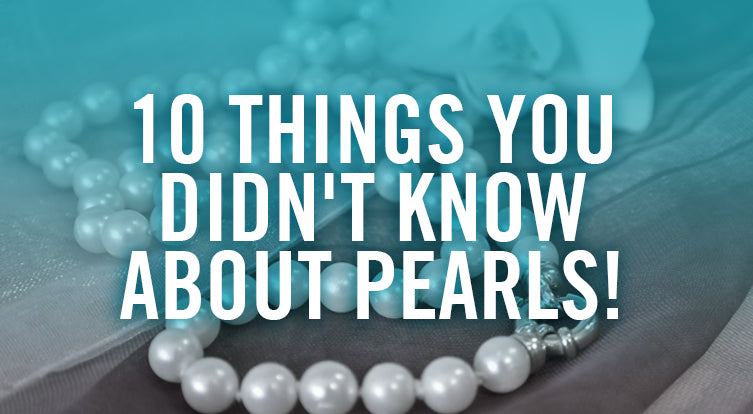10 Things You Probably Didn't Know About Pearls!

Anyone who follows Simple Shine blogs probably knows about my passion for pearls. There is something magical about an organic precious stone. There is a lot of mystery and misconception surrounding pearls so I've decided it is about time to drop 10 things about pearls that you probably didn't know!
One thing that you could probably infer right away is that an organic stone is extremely sensitive. Strong cleaners can damage the pearl and flatten the play of colors, but our gentle complete jewelry cleaning kit has what it takes to clean your jewelry. If you have a necklace or very ornate piece then our foaming jewelry cleaner is gentle and still able to penetrate all those cracks and crevices. With all that out of the way, let's jump back into it.
I've heard the same false statements many times and we're long past due in pushing back and setting the record straight. Some of these oyster facts are slightly disturbing, but I guarantee you that at least one of these pearl facts is guaranteed to blow your mind in one way or another. So let's get started!
Round Pearls Are VERY Rare
If you ask anyone on the street what shape pearls are almost everyone is going to say round, circle, spherical, what have you. The truth is that because of their organic nature it is supremely difficult to find a round pearl. There are 8 recognized pearl shapes: semi-round, round, drop, button, pear, baroque, oval and circled.
The Most Famous Pearl
La Peregrina which is roughly translated as 'the incomparable' is the largest and most famous pearl on the planet. It was found in the Americas and is a massive pear-shaped pearl that is roughly an inch in diameter. Many historical figures have owned La Peregrina at one time or another. Napoleon III, Mary Tudor, Phillip II, and most recently? Elizabeth Taylor.
Pearls Versus Diamonds
Pearls used to be the number one status symbol until diamonds were discovered in the early 1700s and overtook them. Being a new discovery without much of an established market, these diamonds were cheap and because of this diamonds rocketed in popularity. Pearl dealers tried to compete but poor quality and imitation wreaked havoc on the pearl market. While the pearl market did eventually recover somewhat, it was never able to reclaim its status over diamonds.
Sandpaper or Silk?
If you don't spend a lot of time up close and personal with pearls you might assume that their surface is perfectly smooth. Pearls have a look that is silky and gorgeous, but the nacre coating of a pearl consists of millions of crystals that make it more similar to sandpaper. You can experience this grit yourself by rubbing pearl against your teeth.
It Gets Better With Age
While pearls are a sensitive gem that is very susceptible to the cruelty of time, the oyster which the pearls come from actually do get better as they get older. Experience probably has something to do with this, (though there hasn't been much testing of an oyster's muscle memory) but the biggest factor likely comes down simply to size. Bigger oysters can produce bigger pearls so they are quite coveted.
Harvesting Isn't Lethal
Meshing nicely with the first point, we know so much about older oysters because harvesting pearls isn't a lethal practice. It's a common misconception that I've had to correct my own spouse about. Blood diamonds are a serious problem in the diamond trade, but pearls are exceedingly green and sustainable jewels. Pearl farmers are very diligent about caring for their bed. That's the name for a group of oysters: a bed. Just a little bonus fact for you!
White Pearls Aren't The Best Pearls
When most people think of pearls they'll imagine a white gem. The truth is that pearls come in plenty of shades from cream to rose pink to deep black Akoya pearls. Personally I prefer these colorful pearls as they have an impressive play of colors. Most people will be in the market for white pearls but do be careful if you decide to invest in white pearls. Stark white perfect pearls have often been subjected to bleaching which will cause them to have a chalky look and age like milk. Pearls are sensitive stones and bleach is extremely damaging.
Determining the Color of a Pearl
Is it possible for a pearl farmer to determine what color a pearl will be? Absolutely! The outer edge of an oyster reflects what color the pearl inside will become. This is a great way to predict what color pearls a wild oyster will end up producing, but it isn't a catch-all. When farming oysters the determining factor is the color of the outer edge of the oyster that provided the 'pearl seed' or mother of pearl. This means that cultivated oysters can have a black outer edge but still produce white pearls and vice versa!
Sand or... Something Else?
One of the most common myths I hear about oysters is that pearls are created around grains of sand as a method of coping with the irritant. The truth is that oysters have no trouble getting grains of sand out of their shells. What they have a lot more trouble expelling is parasites. You heard it right. At the center of almost all naturally occurring pearls is a parasite. Don't toss out that jewelry just yet though, because you can rest assured that the vast majority of pearls on the market are farmed. These pearls are formed around a sphere of mother of pearl that the farmer inserts.
Predictors of Pollution
Oysters are some of the earliest detection signs of pollutants in the water. Very small levels of pollution will cause oysters to stop producing pearls entirely! This is the reason that pearl farms are always in extremely remote locations where the water is completely pristine. Even these far-off areas are now starting to see problems with pollution however, so we need to make sure we are taking the best possible care of our planet and practice green boating among other environmentally-friendly boating practices. Before it's too late...
Sample Block Quote
Praesent vestibulum congue tellus at fringilla. Curabitur vitae semper sem, eu convallis est. Cras felis nunc commodo loremous convallis vitae interdum non nisl. Maecenas ac est sit amet augue pharetra convallis nec danos.
Sample Paragraph Text
Praesent vestibulum congue tellus at fringilla. Curabitur vitae semper sem, eu convallis est. Cras felis nunc commodo eu convallis vitae interdum non nisl. Maecenas ac est sit amet augue pharetra convallis nec danos dui.
Cras suscipit quam et turpis eleifend vitae malesuada magna congue. Damus id ullamcorper neque. Sed vitae mi a mi pretium aliquet ac sed elitos. Pellentesque nulla eros accumsan quis justo at tincidunt lobortis denimes loremous. Suspendisse vestibulum lectus in lectus volutpat, ut dapibus purus pulvinar. Vestibulum sit amet auctor ipsum.

